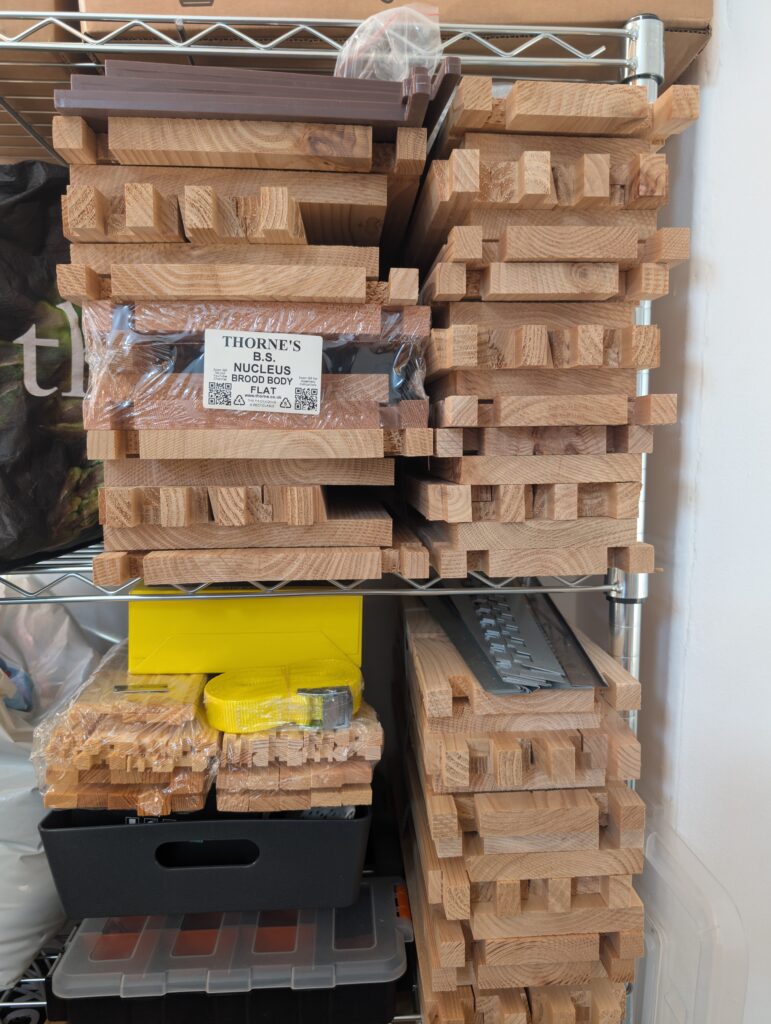There is no slacking off when you’re a beekeeper. It may seem like there isn’t much to do in winter, but that makes it exactly the right time to prepare for the year ahead. Clean equipment, complete repairs, stock up on supplies, read beekeeping literature, be ready!
This is true for any beekeeper, but it’s especially true for Matt this year. 2025 will be a year of growth for Actual Honey, with Matt planning to expand from two colonies to four or five! There is a lot of work to do.
First of all, the hives need to be built.
Matt is accustomed to prolific queens, so each hive will contain two brood boxes to accommodate just how many eggs his queens like to lay. Providing ample space should prevent the bees from getting the urge to swarm.
Every hive will have three supers available, which are the boxes where bees store honey. Matt will have two supers in the hive most of the time, but when he takes those two away to extract the honey, he will temporarily replace them with the third.
All of these boxes need to be assembled since they were delivered as flat pack. Alas, I doubt they came with image-only manuals featuring the legendary IKEA instructions guy. For each hive, there are 22 brood frames and 30 super frames to put together. And that needs to be multiplied by two or three since Matt wants to add two or three hives to his empire. That’s a lot of assembly required! Perhaps this would be a useful tip for Matt:

Of course, empty hives would be pointless and sad. Once they’re built, they need to be filled with honey bees!

Matt will form new colonies by splitting his current ones. But every colony needs a queen. A queenless colony can raise a new queen themselves, but it takes time. She has to grow from an egg into an adult and then she has to mate before she can start laying eggs. Remember, this colony will be half-sized, so building up the population is a priority. So, Matt intends to buy new queens so that they can be installed on the throne pronto.
Once the hives are built and the colonies are back up to size, obviously Matt will have more bees than he did before. Logically, more bees = more honey ∴ Matt needs more honey buckets.
Honey buckets are lidded containers used for storing freshly extracted honey that needs to rest for a few days. During this period, air bubbles and imperfections, such as stray wax, rise to the top where they are easy to remove. This part of the basic honey extraction process helps the final product to look appealing. You can think of it as the honey getting its beauty sleep.
Matt is also thinking ahead to next winter. That may seem crazily far away but I really wasn’t kidding when I said this is the right time to prepare for the upcoming year. Every hive needs its own rapid feeder, so Matt has to buy some more of those too. Rapid feeders are used when a beekeeper needs to supply their bees with food, which is pretty common in the winter when bees can’t go out foraging.

Matt has also been contemplating where his bees will live. Expansion requires more space, so he is investigating a second apiary site. There are a couple of additional benefits to this. Firstly, if he wants to further expand in the future, he has two locations to work with. Secondly, if something goes wrong at one apiary, at least the bees at the other site will be safe. Bees face many hazards, such as outbreaks of disease, so this is a wise precaution. There is a particularly high risk of this if Matt were to catch a new swarm because the health of these bees would be unknown. Being able to keep them in isolation gives him time to don his white coat and perform a medical examination, whereas if they were amongst his other colonies, any illnesses could spread to all of his bees.
The Actual Honey expansion project will take a lot of hard work and there is a lot to consider, but it will absolutely be worth it. Matt is thrilled to have the chance to spend more time with honey bees. And, don’t forget, more bees = more honey. Watch this space if you want some Actual Honey in your cupboard!